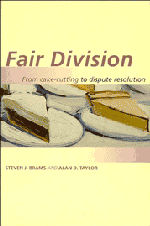Book contents
- Frontmatter
- Contents
- List of figures
- List of tables
- Acknowledgments
- Introduction
- 1 Proportionality for n = 2
- 2 Proportionality for n > 2: the divisible case
- 3 Proportionality for n > 2: the indivisible case
- 4 Envy-freeness and equitability for n = 2
- 5 Applications of the point-allocation procedures
- 6 Envy-free procedures for n = 3 and n = 4
- 7 Envy-free procedures for arbitrary n
- 8 Divide-the-dollar
- 9 Fair division by auctions
- 10 Fair division by elections
- 11 Conclusions
- Glossary
- Bibliography
- Index
Introduction
Published online by Cambridge University Press: 05 July 2011
- Frontmatter
- Contents
- List of figures
- List of tables
- Acknowledgments
- Introduction
- 1 Proportionality for n = 2
- 2 Proportionality for n > 2: the divisible case
- 3 Proportionality for n > 2: the indivisible case
- 4 Envy-freeness and equitability for n = 2
- 5 Applications of the point-allocation procedures
- 6 Envy-free procedures for n = 3 and n = 4
- 7 Envy-free procedures for arbitrary n
- 8 Divide-the-dollar
- 9 Fair division by auctions
- 10 Fair division by elections
- 11 Conclusions
- Glossary
- Bibliography
- Index
Summary
The problem of fair division is as old as the hills, but our approach to this problem is new. It involves
setting forth explicit criteria, or properties, that characterize different notions of fairness;
providing step-by-step procedures, or algorithms, for obtaining a fair division of goods or, alternatively, preferred positions on a set of issues in negotiations; and
illustrating these algorithms with applications to real-life situations.
Our three-pronged focus on properties, algorithms, and applications pulls together work scattered in different disciplines. Thus, philosophers have devoted major attention to explicating the meaning of fairness, and related concepts like justice and equity, and spelling out some of their implications. Theoretical economists have postulated abstract properties that any fair-division scheme should satisfy, but their demonstration of the existence of such a scheme usually says little about how, constructively (i.e., by the use of an algorithm or step-by-step procedure), to produce a fair division. Mathematicians have proved nonconstructive existence results as well, but they have been more interested than economists in also developing algorithms that actually produce a fair division.
Political scientists, sociologists, and applied economists have taken a more empirical tack, seeking to determine conditions under which fairness, or departures from it, occur in the world and what consequences they have for people and institutions. Psychologists have especially paid heed to how perceptions of fairness impinge on people's attitudes and affect their behavior.
- Type
- Chapter
- Information
- Fair DivisionFrom Cake-Cutting to Dispute Resolution, pp. 1 - 5Publisher: Cambridge University PressPrint publication year: 1996



